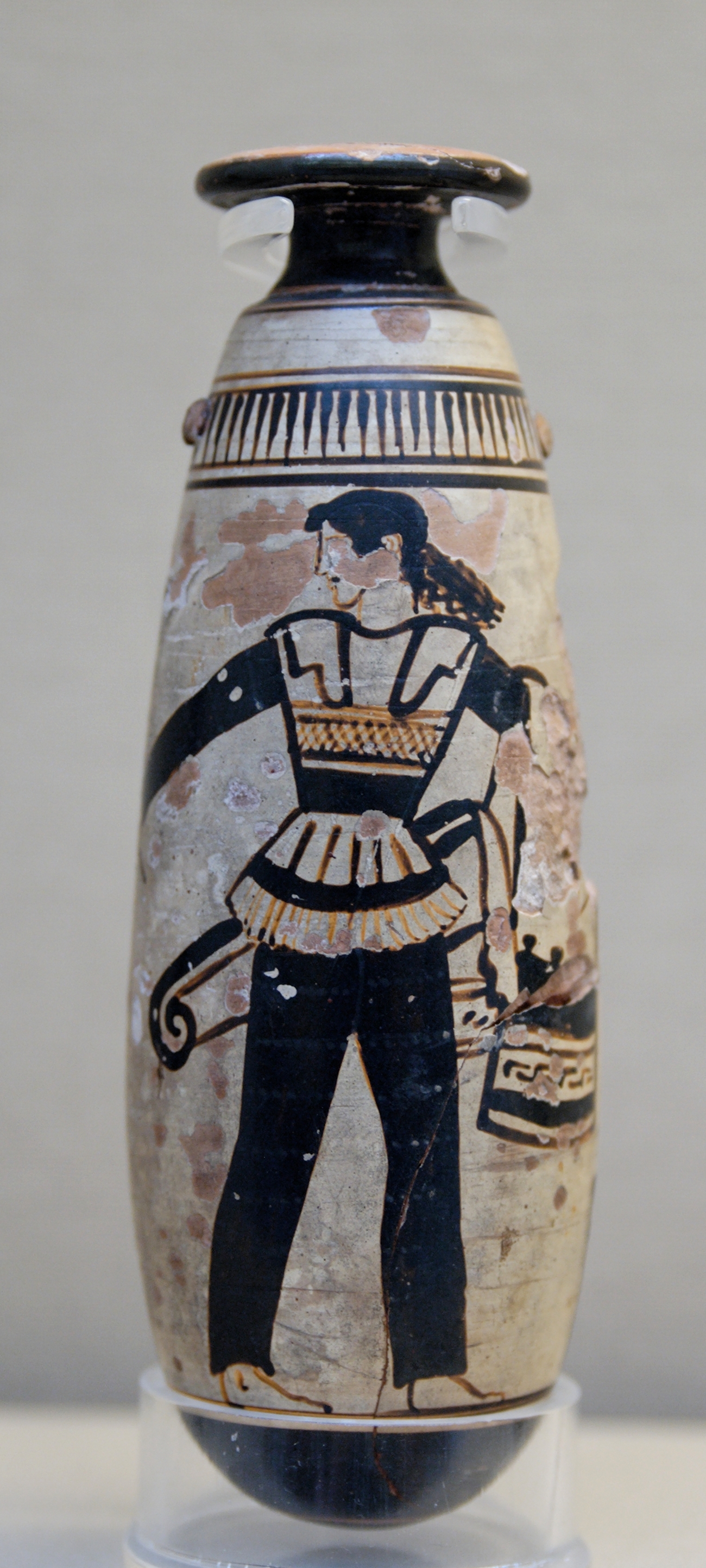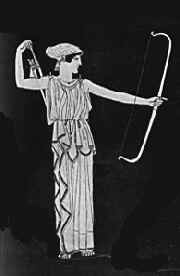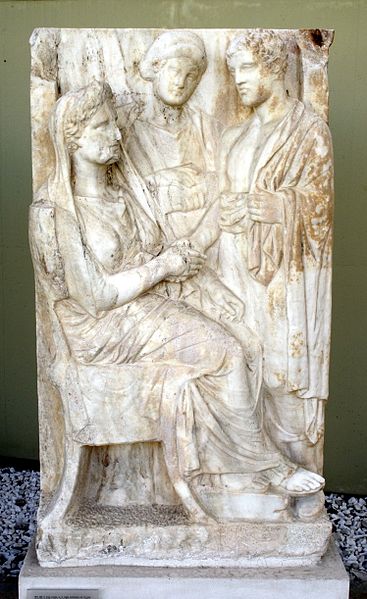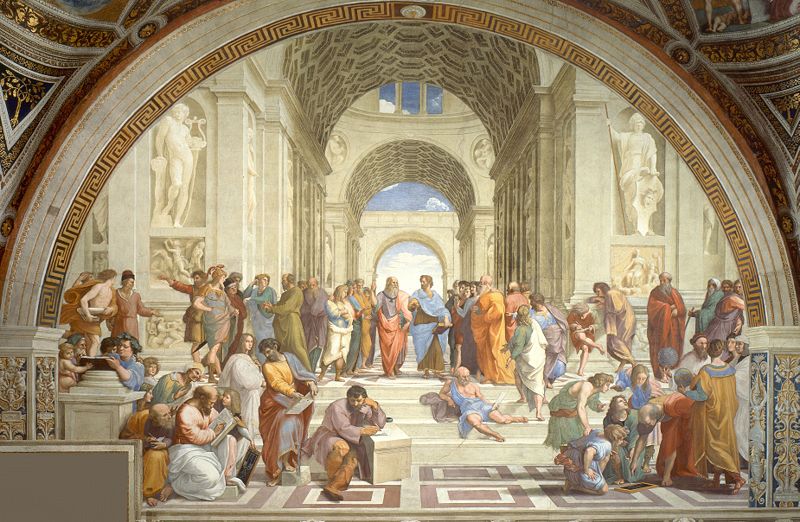Focus Question: What was the status of women and slaves in ancient Athens and how did they live their lives?
Image shows a seated woman leaving her child to a nurse, 425-400 BCE

Topics on the Page
Women in Ancient Athens
Comparison of Women's Roles in Athens and Sparta
Slaves in Ancient Athens
 CROSS-LINKS
CROSS-LINKS
Athens and Sparta
WOMEN ROLES
In Aristotle's On a Good Wife, written in 330 BCE, he declared that a good wife aims to "obey her husband; giving no heed to public affairs, nor having any part in arranging the marriages of her children."
- In Ancient Greece, only adult, non-slave, native males (not foreigners) had the right to vote and participate in government.
- Education and sporting events were also largely reserved for this group—which, by the way, only comprised 10-20% of the population. Needless to say, this group formed the dominant culture of Ancient Greece.
- Because most women and slaves were not literate, they could not write their own stories. We do know some about their lives from the writings of educated men and from art.
- Much of the information we do have is from Athens and Sparta—it is interesting to see the differences in the lives of women in the two city-states.
For a quick reference guide outlining women's various roles in Ancient Greece click here.
For a quick video guide outlining the Role and Rights of Women in Ancient Greece click here
https://www.youtube.com/watch?v=5-ASzrpGZ-k

- A teaching Case Study on Women in Classical Athens and Sparta by Judy Gaughan from the University of Colorado. It includes a number of primary sources that explore the lives of women in the classical world
- For a list of primary resources that demonstrate the various roles of women in Greek society click here.

 Click here for a PBS summary of the role of women in Athens. It mentions the similarities in treatment between women and slaves in the city-state. Women in Athens.
Click here for a PBS summary of the role of women in Athens. It mentions the similarities in treatment between women and slaves in the city-state. Women in Athens.
- Women didn't have much power in the government, but did have influence through their children and other sources.
Much of what is known about the role of women in Ancient Athens comes from artwork as well as documents. To see some of the pieces of art that have contributed to women's history in Athens go to the University of Pennsylvania Museum of Archaeology.
Click here for a video on Women in Ancient Greece
Artemesia I of Caria
- Artemesia was granted the throne of Caria, a Persian province, due to the mysterious death of her unnamed husband and the youth of her son.
- According to Polyaenus, A 2nd century Macedonian historian and author, she was a skilled naval expert who served as a top advisor King Xerxes during the battle of Salamis in 480 BC.
- After the successful Persian invasion and destruction of Athens, the majority of the Persian military hierarchy suggested a swift final blow to the Greeks at sea. Artemisia was the lone dissenter to this plan.
- She suggested a land campaign towards the Peloponnese to stretch out the Greek Army.
- However, Xerxes ignored her suggestion and decided to engage the Greek navy in the battle of Salamis. The campaign was a crushing defeat to the Persia Navy.
Gorgo, the Queen of Sparta, is one of the only women mentioned in Herodotus's account of the Persian Wars.
"Whatever her looks, Gorgo was the quintessential Spartan woman in spirit. She was educated, self-confident, out-spoken and involved in the body politic. She was neither vain nor materialistic. She showed Spartan scorn of affectation when she thought Aristagoras had no hands because he let a slave dress him, and when she accused an elegantly dressed man of not being able to play even a female role."
Woman from Athens suburbs by Stackelberg

- Most Athenian philosophers, who were very influential in their time, thought that women had strong emotions and weak minds. (Plato did not, however, hold this view—it is also interesting to think about the disparity between the power of Goddesses and the powerlessness of mortal females.)
- Women in Ancient Athens were not allowed to own major property—in fact, all she was allowed to own were her clothes, jewelry, and personal slave(s). She could buy some cheap items, but for the most part did not have access to money.
- Elite men in Athens saw non-slave women either as wives or potential wives. This is indicative that women were valued for their function in society rather than their individuality.
- Women usually married shortly after puberty—their husbands were often about 20 years older than they were.
- Each elite Athenian woman had a Guardian (called a kyrios)—this was either her husband or closest male relative. He was assigned to protect her and make decisions regarding her life.
- Wives spent most of their time in the home. Women sometimes gathered with other women for religious ceremonies. They also left the house for occasions such as funerals.
- If a woman was not a wife, chances are she worked to serve men in one of the following ways:
- Prostitutes either worked in brothels (where they were controlled by brothel owners) or on the street, where they may have had more control over their lives—although there were various laws regarding how much they could charge and what they could wear.
- Heretas had much more freedom than wives. They were able to do as they pleased, and were often hired by men for entertainment. This could include sex but more likely included flirtatious behavior and conversation. Heretas were unusual among women in that they were known for their knowledge of the world and their intellectual vigor. Most heretas worked at male gatherings but some entertained in their own homes. Because of this, these women could have some political influence in Athenian society by expressing and arguing their personal opinions to the male citizens.
- Concubines were considered to be above prostitutes and Heretas. Concubines had more permanent relationships with men and acted as their mistresses.
- Wives, out of all of these women, were considered the least desirable to men—their role was simply to produce and rear children and run the home.
- Priestesses were needed for religious ceremonies. Although they remained unmarried they still had a high status and were well respected.

- Women in Sparta could own property—they may have actually owned 1/3 of Sparta.
- Women could inherit wealth, although probably did not inherit as much as their male counterparts.
- Spartan women, like the men, were bold and powerful. They participated in sports.
- While Spartan women had some influence in politics, it remained largely the domain of men.
- Spartan women, like their Athenian counterparts, held the responsibility of producing offspring. This pressure may have been even stronger in Sparta, since any “imperfect” baby was left to die.
- Spartan girls had more access to arts and education.
- Spartan girls did not have to marry as young as Athenians did, and their husbands were closer in age to them.
- Women only raised their sons until the age of seven—after that their sons went off to rigorous military training.
(Note—the above comments are relevant only to non-slave women)
Book: Women and Politics in Ancient Rome, Richard A. Bauma
 For an interactive comparison of Spartan and Athenian male and females from the British Museum click here.
For an interactive comparison of Spartan and Athenian male and females from the British Museum click here.
For a comprehensive look at life in Ancient Greece, including the roles played by women and slaves, click here to listen to "Ancient Greece: City and Society," by Dr. Gillian Shepherd on iTunes.
For a theoretical look at the gendered spaces of Ancient Greece, check out James Davidson's article Sexing Space and Zoning Gender in Ancient Athens
Check out these podcasts that provide a perspective on the role of women as understood by ancient greek literature and philosophers

Slaves
Image to the right shows a woman greeting her son; between them, a female slave (4th century BCE)
"The modern term that is used to refer to the type of slavery found in ancient Athens (and in most other Greek poleis) is 'chattel slavery'. . . That is, Athenian slaves were the living property of their owners; they could be sold at will or they could be beaten and branded and forced to work for their owners like an ox. . . .a slave was considered to be inherently inferior in character to his citizen/owner" (quoted in Ancient Greek Civilization, David Sansone, Second Edition, Wiley-Blackwell, 2009, p. 131).
- About a quarter to one third of those living in Athens were slaves.
- Slaves in Athens are known to be treated much different than one would expect. I
- Enslaved people were not allowed to be citizens, regardless of gender.
- Slavery was thought of as a normal part of life in Ancient Greece.
- Slaves outnumbered adult male citizens in Athens, perhaps by a large number (Ancient Greek Civilization, David Sansone, Second Edition, Wiley-Blackwell, 2009, p. 132).
- Many female slaves worked as prostitutes in brothels. They also had to weave or do other tasks for brothel owners.
- On average, most slaves were expected to complete 250 jobs in one day. If these jobs were not completed by the end of the day, the master often times would whip them.
- The life of a slave varied depending on their type of work. Domestic slaves, which were usually women, could be part of the family, while other slaves who work as war ship rowers face dangerous conditions.
- Slavery was different then in the sense that it was not based on the subjugation of an entire people. It was not racially or ethnically based.
For a summary on the the role of slaves in Greek society click here.

For an interactive resource on what it was like to be a female slave in a Greek family click here.
Reasons for enslavement:
- If they were on the losing side of a war.
- Captured while traveling.
- Born into slavery.
- Abandoned at birth, and claimed by anyone who wanted it.
- If a family was in need of money, a child could be sold into slavery.
Types of Slaves
- Public Slaves: Slaves that were owned by the government.Their jobs included scribes, accountants, prison attendants, executioners, clerks, and secretaries.
- Some slaves who were owned by the state were used as "police" by the government.
- Enslaved people could also have the role of attending a certain woman or other important person.
- Private Slaves: Slaves that were owned by an individual.
- Their jobs included household chores such as maids, we-nurses, messengers, and teachers.
- Others worked in the fields,
- Many domestic slaves were so close with the family that they served, some were almost considered part of the family. Many domestic slaves had an opportunity to buy their own freedom.
- Particularly in Sparta, slaves were responsible for nearly all the agricultural work.
To find out more about Greek slavery explore these primary resources from Fordham University.
For an explanation of the difference between the Athenian slave and the Spartan Helot click here.
Click here for more on slavery in Ancient Greece from History For Kids
Click here for a video on Slavery in Ancient Greece
The importance of Roman slaves was critical in their society.
This painting was meant to represent Greek philosophy and democracy but, as John Green points out, there is always more to the story than what is in the traditional narrative.
 |
| The School of Athens by Renaissance artist Raphael |
Although Greece, and Athens in particular, are cited as the origins of democracy, philosophy etc. many overlook their subjugation of women and their use of slavery.
- View John Green's Crash Course to gain a better understanding of historical bias and how it has affected the retelling of Greek history.
Sources:
Thompson, James C. (2005). Women Athens. Retrieved February 14, 2007, from Women in the Ancient World Web site: http://www.womenintheancientworld.com/women%20in%20ancient%20greece.htm
Thompson, James C. (James). Women in Sparta. Retrieved February 14, 2007, from Women in the Ancient World Web site: http://www.womenintheancientworld.com/women%20in%20sparta.htm
New images obtained from Wikimedia Commons on 14 June 2011.
Comments (0)
You don't have permission to comment on this page.